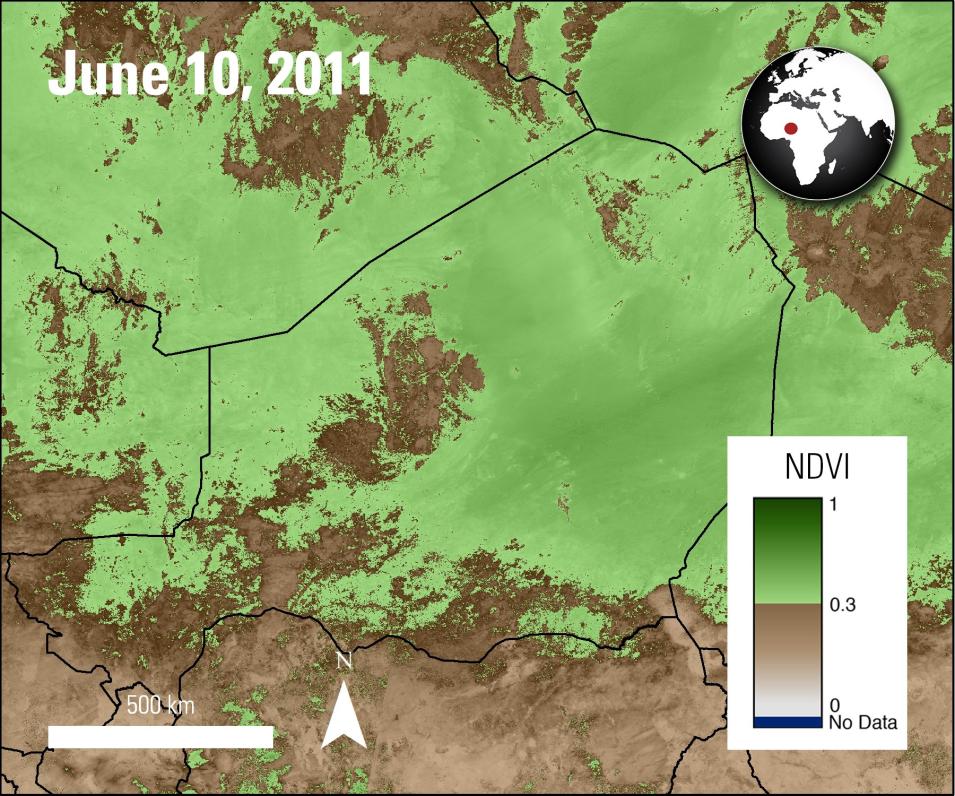Science Objectives
In this paper, "Unexpected Evergreen Expansion in the Siberian Forest under Warming Hiatus" published in Journal of Climate, He and others (2017) examine changes in the Siberian Forest using several MODIS data products and other data sources. Overall, the forest has been experiencing a warming period over the past several decades. However, during recent winters the forest has experienced a significant cooling period, which was 10 times cooler than what all of the Northern Hemisphere experienced at the same time. The forest is seeing an increase in evergreen conifers due to the warming period; however, evergreen conifers typically do not fare well during the colder winters. The temperatures can cause damage to the trees and increase the mortality of younger evergreens in the forest.
Instruments Used
The authors use the MODIS Land Cover data product (MCD12Q1) for 2001 to 2012 to examine how these trees respond to temperature cooling in the forest. The authors use the MODIS Burned Area Product (MCD45A1) and the Global Fire Emissions Database to examine if fire is the cause of the transition from deciduous to evergreen forest. They then use the Terra MODIS Vegetation Continuous Fields (VCF) (MOD44B) data product to confirm their conclusions.
Major Findings
Over the study period, the amount of evergreen conifer forest area has increased and expanded by 10 percent, in contrast to the deciduous conifer forest, which decreased by 40 percent. Fires were not found near the regions of forest transition. The new evergreen forests began to occupy buffer areas in forests that were previously home to mixed forests and woody savannas. The authors recommend using albedo data in the future to distinguish forest types. While the winter cooling period was extreme, it was still warmer than the previous hiatus of 1940 to 1960. The authors believe a severe increase in evergreen conifers is possible with warming trends and forecasted temperature increases of 4–10°C in the region, though more research on fire, permafrost, and drought is needed.
References
Publication Reference
He, Y., Huang, J., Shugart, HH., Guan, X., Wang, B., and Yu, K., 2017, Unexpected Evergreen Expansion in the Siberian Forest under Warming Hiatus: Journal of Climate, v. 30, no. 14, p. 1114–1136. doi:10.1175/JCLI-D-16-0196.1
Image References
Granule IDs
- MCD12Q1.A2012001.h24v04.051.2014288202436
- MCD12Q1.A2012001.h21v03.051.2014288201909
- MCD12Q1.A2012001.h21v02.051.2014288201906
- MCD12Q1.A2012001.h22v02.051.2014288202054
- MCD12Q1.A2012001.h22v03.051.2014288202106
- MCD12Q1.A2012001.h23v04.051.2014288202306
- MCD12Q1.A2012001.h20v02.051.2014288201706
- MCD12Q1.A2012001.h23v03.051.2014288202253
Agricultural Droughts Across Africa
MODIS surface reflectance and vegetation indices are used to track large-scale drought impacts on agriculture across Africa in connection with El Niño Southern Oscillation (ENSO) phases.


